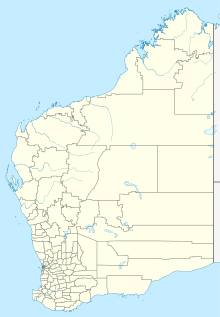Marandoo mine
| Location | |
|---|---|
| Location | Shire of Ashburton, Pilbara |
| State | Western Australia |
| Country | Australia |
| Coordinates | 22°38′25″S 118°07′15″E / 22.640150°S 118.120796°E |
| Production | |
| Products | Iron ore |
| Production | 15 million tonnes/annum |
| History | |
| Opened | 1994 |
| Owner | |
| Company | Rio Tinto Iron Ore |
 | |
The Marandoo mine is an iron ore mine located in the Pilbara region of Western Australia, 45 kilometres east of Tom Price.[1]
The mine is fully owned and operated by Rio Tinto Iron Ore and is one of seventeen iron ore mines the company operates in the Pilbara.[2][3] In 2009, the combined Pilbara operations produced 202 million tonnes of iron ore, a 15 percent increase from 2008.[4] The Pilbara operations accounted for almost 13 percent of the world's 2009 iron ore production of 1.59 billion tonnes.[5][6]
The mine, alongside the rail, is within a narrow corridor that splits Karijini National Park into a northern and a southern half.[2] The Hamersley Range, where the mine is located, contains 80 percent of all identified iron ore reserves in Australia and is one of the world's major iron ore provinces.[7]
Overview

Marandoo was formerly located in the Karijini National Park until it was excised in 1991 to allow for mining operations to commence. An associated rail corridor was excised allowing transport of the ore to the coast to the west, and to connect with future mines to the east.[8]
Rio Tinto iron ore operations in the Pilbara began in 1966.[2] The mine itself began operations in 1994. The mine has an annual production capacity of 15 million tonnes of iron ore, sourced from open-pit operations. The ore is processed on site before being loaded onto rail.[9]
Ore from the mine is then transported to the coast through the Hamersley & Robe River railway, where it is loaded onto ships.[10] Ore from Marandoo, like Brockman, Mount Tom Price, Paraburdoo, Channar, Eastern Range and Yandicoogina are transported as lump and fines ore product from the mines to Dampier via rail. Before being loaded onto ships for export, the product is blended and rescreened. The maximum size for the lumps is 31.5 mm, while the fines are at a maximum of 6.3 mm.[11]
Marandoo opened in October 1994 and was, at the time, the showpiece mine in regards to best practice design for Hamerley Iron.[12]
The mine is owned by Hamersley Iron Pty Ltd, a fully owned subsidiary of Rio Tinto, which owns 13 mines in the Pilbara, including Marandoo.[13]
The mines lifetime was extended another 20 years in the early 2010s when its lease was modified to allow it to extended below the natural water table. Groundwater is currently pumped to plains outside Karijini, where Rio is growing hay and supporting cattle.[14][15]
Workers
The mine's workforce is on a fly-in fly-out roster,[9] having originally been based residential, until the town became too small for the workforce.[16] In 2009, the mine employed 355 people, an increase in comparison to 2008, when it only employed 250.[13]
Tourism
The mine can be seen from Mount Bruce, the second-highest mountain in Western Australia, located within Karijini National Park and the Hamersley Range.[17]
References
- ^ MINEDEX website: Marandoo search result Archived 2008-09-11 at the Wayback Machine accessed: 6 November 2010
- ^ a b c Pilbara Archived 2013-10-21 at the Wayback Machine Rio Tinto Iron Ore website, accessed: 6 November 2010
- ^ Mining Archived 2010-06-12 at the Wayback Machine Rio Tinto Iron Ore website, accessed: 6 November 2010
- ^ Preparing for the future Archived 2011-07-15 at the Wayback Machine Rio Tinto presentation, published: 23 March 2010, accessed: 7 November 2010
- ^ Global iron-ore production falls 6,2% in 2009 - Unctad report miningweekly.com, published: 30 July 2010, accessed: 7 November 2010
- ^ Production of iron ore fell in 2009, but shipments continued to increase, report says[permanent dead link] UNCTAD website, published: 30 July 2010, accessed: 7 November 2010
- ^ Iron fact sheet - Australian Resources and Deposits Archived 2011-02-18 at the Wayback Machine Geoscience Australia website, accessed: 7 November 2010
- ^ "Karijini National Park Management Plan, 1999-2009" (PDF). p. 9. Archived from the original (PDF) on 2011-03-12.
- ^ a b Marandoo mine Archived 2011-06-23 at the Wayback Machine Rio Tinto Iron Ore website, accessed: 6 November 2010
- ^ Rail Archived 2013-07-01 at the Wayback Machine Rio Tinto Iron Ore website, accessed: 6 November 2010
- ^ Iron fact sheet - Mining Archived 2011-02-18 at the Wayback Machine Geoscience Australia website, accessed: 7 November 2010
- ^ The Australian Mines Handbook - 2003-04 edition, editor: Ross Louthean, publisher: Louthean Media Pty Ltd, page: 241
- ^ a b Western Australian Mineral and Petroleum Statistic Digest 2009 Department of Mines and Petroleum website, accessed: 7 November 2010
- ^ "Reeling easy during large-scale dewatering". 5 June 2019.
- ^ "Making Hay". Australian Broadcasting Corporation. 21 April 2013.
- ^ Fly in, fly out plans for Marandoo mine ABC News, published: 26 May 2005, accessed: 7 November 2010
- ^ Karijini National Park - Top 5 attractions Karijini National Park website, accessed: 7 November 2010
External links
- Webarchive template wayback links
- All articles with dead external links
- Articles with dead external links from June 2017
- Articles with permanently dead external links
- Articles with short description
- Short description matches Wikidata
- Coordinates on Wikidata
- Infobox mapframe without OSM relation ID on Wikidata
- Iron ore mines in Western Australia
- Surface mines in Australia
- Rio Tinto Iron Ore
- Hamersley Range
- Shire of Ashburton
- 1994 establishments in Australia
- Pages using the Kartographer extension
